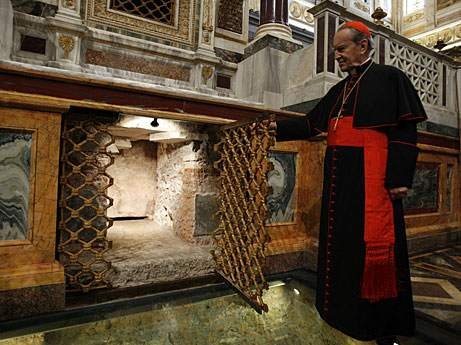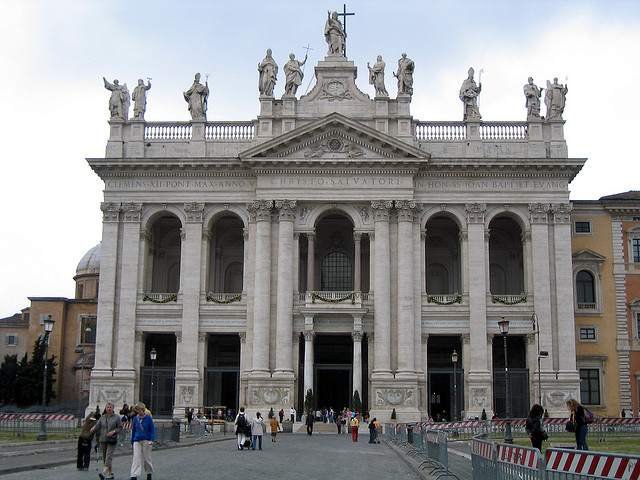In 2005, I had the opportunity to travel to Italy with Dr. G and a small class of students, most of them members of the Society (and so passionate nerds for Latin and antiquity like me). It was a course on the history of the city of Rome, and in two weeks, we covered some 3,000 years of Roman history, from Romulus to Mussolini. In the mornings, Dr. G lectured us, and in the afternoons, we went out into the city to tour the sites that pertained to that day’s period of history. The whole expanse of history is right there before you in Rome, to see and experience. It was magical.
This was the culmination of three years of tutelage under Dr. G. But all was not well. I had just run aground of two of the unhealthiest, most disastrous semesters in my entire college career, one after the other. My academic future stood precariously on the rocks, and even amid the wonder and joy of being in Rome, I struggled against despair and hopelessness. In a minor coup, I forced out a research paper in the week before I left — on the Christian Catacombs of Rome — and handed it to Dr. G as I was boarding the plane. And I tried to leave my catastrophe behind me.
The trip was too full and too vivid and too wonderful to cover here in any great detail. I kept extensive journals while I was in Italy, striving to capture every moment. Because of this, most blessedly, I am able to re-create my thoughts and feelings at the time of my experiences, unclouded by the years. More than any other fruit of this journey — though I had no notion of it at the time, and only now, seven years later, am realizing it — it laid the paving stones of my journey to the Church.
We arrived in Rome on a Saturday. The next day, Sunday, we collectively decided to go to Mass — when in Rome, do as the Romans do. We picked the Basilica of St. John Lateran, the cathedral of Rome, which wasn’t on our itinerary otherwise. It was only two days after Pope Benedict XVI had had formally taken possession of it as pope and bishop of Rome. It was a glorious choice for my first Roman church and my first Roman Mass. The account from my Roman journal:
We arrived at the church just as the ten o’clock Mass was ending. Outside it was impressive, but that was nothing compared to what I saw inside. Immediately upon walking through the doors, I was so awed by the size, beauty, and magnificence that I began to weep. The ceilings were high and vaulted, and everywhere was ornate work in gold. Splendid paintings and mosaics covered the walls. In alcoves along the walls were Baroque statuary of the twelve Apostles that looked as if the Apostles were about to come alive and walk among us. High above the altar rested the relics of St. Peter and St. Paul. I felt I was in the presence of God.
By this time, I had been drifting spiritually for about seven years. I always called myself a Christian, always thought of God from time to time; but I hadn’t been going to church regularly, praying, or reading my Bible for a very long time. I felt that God had forsaken me, when in truth I had forsaken Him, choosing instead idols and sins and spiritual oblivion. But in Rome, from this very first moment, I was awakened to His presence. If there was anywhere where I could encounter God, I thought, it was in these ancient churches in this eternal city, where saints and martyrs had walked.
A couple of days later, we took a trip down to the EUR, Mussolini’s planned city district. Our plan was to visit the Museo della Civiltà Romana (Museum of Roman Civilization), with its scale model of ancient Rome — but when we got down there, it was closed. The rest of our day was now open; what else would we do? Hibernius, my Catholic convert friend, and I made the case for us to take the subway back up a couple of stops to St. Paul outside the Walls.
The Basilica of St. Paul outside the Walls is one of the four major basilicas of Rome. It is also the traditional burial place of St. Paul, over which the Emperor Constantine built the original basilica in the early fourth century. Only months earlier, I had read the first whisperings of a remarkable discovery there: Vatican archaeologists had discovered Paul’s sarcophagus. The plaque over it read, “Apostle Paul, Martyr.”
I went to the church with this on my mind. We entered the church through the apse end, so I didn’t get the impact of the façade; but I was immediately impressed with the church’s size and grandeur. That’s not what really moved me, though. I made my way to the high altar. There I saw the representation of a tomb (not the ancient sarcophagus, I realized) at the foot of it. Being generally unfamiliar with Catholic churches and relics, I wasn’t sure if this was where Paul’s tomb had been discovered or not. I anxiously queried Hibernius, and he found a priest who spoke English and asked him. It was.
When I found out, I was overwhelmed. I knelt down at the altar, and tears began streaming down my face, as the words of St. Paul, which have always meant so much to me, echoed in my head, and I thought of the road to Damascus. ‘Thank you, Lord, for sending your servant Paul,’ I prayed.

Cardinal Andrea Cordero Lanza di Montezemolo, Archpriest of Rome's Basilica of St. Paul's Outside-the-Walls, shows the passageway through which one side of St. Paul's stone coffin is visible. (National Geographic)
I’m not sure how long I knelt there praying — ten, fifteen, thirty minutes? — but when I looked up, I saw my friends and classmates standing there looking concerned. They were ready to leave, but wanted to give me my time. As we left, several of them thanked me for bringing them there. Several people told me later that it was their favorite place to visit. It was certainly the highlight of my trip.
I had a touch from God that day, and I knew it — my first true religious experience in a number of years. From then on, my time in Rome became a pilgrimage. Visiting churches was what I most looked forward to; and I was acutely aware of God’s presence in them and my experience of Him. I remember commenting, thinking little of it at the time, that it was hard to stand in those churches and not want to be Catholic.
Before I left St. Paul’s, I bought a small statue of the Apostle. Even at the time I bought it, I was conscious of it being more than just a souvenir: it was an object of devotion. That statue has stood on my bookshelf ever since, watching over me; as I believe St. Paul himself has watched over me, and guided me home to Rome. I wasn’t aware of it then, but God was working, slowly but deliberately, to bring about my redemption.




Pingback: Before St. Paul’s Tomb « Catholicus nascens
Pingback: The Tomb of St. Peter « Catholicus nascens
Pingback: What is a Saint? « The Lonely Pilgrim
Pingback: Seeing the Pope « The Lonely Pilgrim
Pingback: Saints Peter and Paul: Apostles to the Protestants? « The Lonely Pilgrim
Pingback: Off the map « The Lonely Pilgrim
Pingback: What is a Saint? An Introduction for Protestants « The Lonely Pilgrim
Pingback: In the Vineyard « The Lonely Pilgrim
Pingback: Corpus Christi: The Latin Corpus of Christ; and the Real Schism (in my mind) | The Lonely Pilgrim